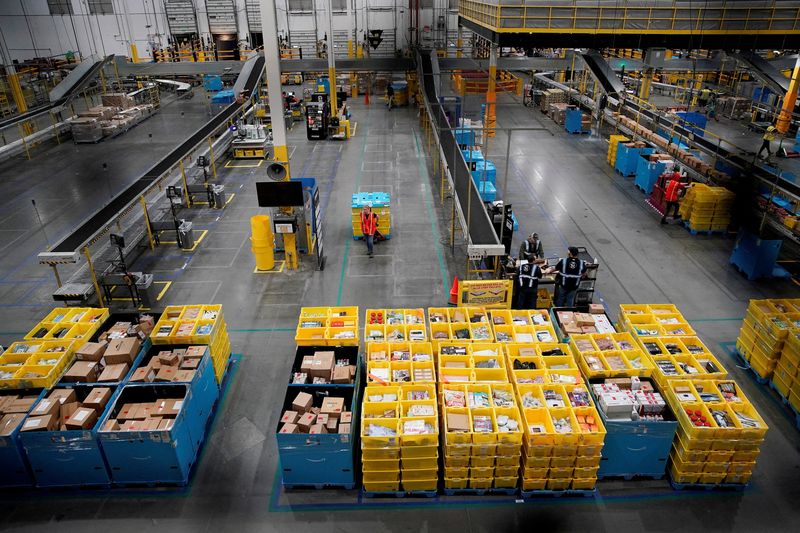By Lucia Mutikani
WASHINGTON (Reuters) - U.S. producer prices rose slightly more than expected in November amid a jump in the costs of services, but the trend is moderating, with annual inflation at the factory gate posting its smallest increase in 1-1/2 years.
The report from the Labor Department on Friday also showed underlying producer prices increasing at their slowest pace since April 2021 on a year-on-year basis. Consumers' one-year inflation expectations fell to a 15-month low in December, other data showed.
The reports were published ahead of the Federal Reserve's two-day policy meeting next week, at which the U.S. central bank is expected to start dialing back the size of its interest rate increases. Consumer prices data next week will shed more light on the path of inflation.
"Easing producer prices foreshadow an improving inflation environment," said Jeffrey Roach, chief economist at LPL Financial (NASDAQ:LPLA) in Charlotte, North Carolina. "The Fed will likely downshift the pace of rate hikes next week and should continue to downshift in 2023. However, the monthly increase in producer prices illustrates the need for continued tightening."
The producer price index for final demand rose 0.3% last month. Data for October was revised up to show the PPI gaining 0.3% instead of 0.2% as previously reported.
A 0.4% rise in prices for services accounted for the increase in the PPI. Services, which edged up 0.1% in October, were last month driven by an 11.3% surge in the costs of securities brokerage, dealing, investment advice and related services. Prices for machinery and vehicle wholesaling, portfolio management and long-distance motor carrying also rose.
But the cost of airline tickets tumbled 5.7%. Prices for automobiles and parts dropped while the cost of hotel accommodation fell 1.6%. Healthcare costs rose moderately.
Portfolio management fees, airline tickets, healthcare and hotel accommodation go into the calculation of the personal consumption expenditures (PCE) price index, excluding the volatile food and energy components. The Fed tracks the so-called core PCE price index for its 2% inflation target.
Goods prices nudged up 0.1% after accelerating 0.6% in October. A 3.3% increase in food prices was offset by a 3.3% drop in energy costs. Excluding food and energy, wholesale goods prices increased 0.3% after being flat for two straight months.
This solid increase in core goods prices poses an upside risk to the core goods disinflationary trend that was evident in recent consumer price index data. The government is scheduled to release November's CPI report next Tuesday.
"While core goods prices in CPI are still very likely to decline in November given falling used car prices, a renewed increase in core goods PPI highlights that there remain some underappreciated upside risks to goods prices into next year," said Veronica Clark, an economist at Citigroup (NYSE:C) in New York.
In the 12 months through November, the PPI increased 7.4%. That was the smallest gain since May 2021 and followed an 8.1% advance in October. Economists polled by Reuters had forecast the PPI climbing 0.2% and rising 7.2% year-on-year.
Stocks on Wall Street were trading higher. The dollar was little changed against a basket of currencies. U.S. Treasury prices fell.
INFLATION GRADUALLY SLOWING
A separate report from the University of Michigan showed its measure of consumers' one-year inflation expectations fell to 4.6% this month, the lowest reading since September 2021, from 4.9% in November. The survey's five-year inflation outlook was unchanged at 3.0% in December.
"The big picture is that there is still no evidence of inflation expectations becoming unanchored," said Andrew Hunter, a senior U.S. economist at Capital Economics.
Inflation is gradually slowing as supply chains ease and demand for goods ebbs. The Institute for Supply Management last week reported that its measure of prices paid by factories for goods dropped to a 2-1/2 year low in November.
But the shift in spending to services means overall inflation will remain elevated for a while. Some of the price pressures are seen coming from the labor market, with wage growth accelerating in November.
That has left economists expecting the Fed will continue tightening monetary policy and lift its policy rate to a level higher than the recently projected 4.6%, where it could stay for some time. The central bank has raised the policy rate by 375 basis points this year from near zero to a 3.75%-4.00% range, in the fastest rate-hiking cycle since the 1980s.
Excluding the volatile food, energy and trade services components, producer prices gained 0.3% in November. The core PPI rose 0.2% in October. In the 12 months through November, the core PPI advanced 4.9%, the smallest rise since April 2021, after increasing 5.4% in October.
With the PPI components that feed into the core PCE price index mostly soft, economists believe this inflation measure likely rose by about 0.2% in November, which would lower the annual increase to around 4.7%. The core PCE price index gained 0.2% in October and was up 5.0% year-on-year.
"Inflation is moving in the right direction, though at a slow pace," said Kurt Rankin, a senior economist at PNC Financial (NYSE:PNC) in Pittsburgh, Pennsylvania.
